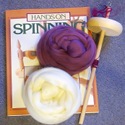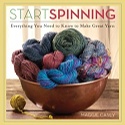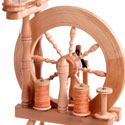Getting started
Teasing
This is a quick and cheerful way to get started. Simply pull a few locks of wool from your fleece and pull them apart a little with your fingers to separate the fibres.
Getting started
Tie a piece of scrap yarn to the spindle. Wind it around the spindle, hook it on the hook and give the spindle a spin. This is called a leader. Pull out a little of your fibre and allow it to catch the end of the leader and start to twist. To make this easier, you can tie a loop at the end of your leader and thread a few of your fibres through this loop.
Always spin the spindle in the clockwise direction, and don't neglect it and allow it to start to spin anti-clockwise.
Some new starters like to spin the spindle and then 'park' it between their knees while they draft some fibre, and then give the spindle another spin. This gives you fewer things to think about at once.
Drafting
Hold the fibre loosely at point B and more tightly at point A. Pull your hands apart until you've achieved the thickness you like, and then bring your fingers at point A back towards point B, allowing the twist to travel up the part you've just drawn. Pinch again with your front hand (right hand in this diagram) to stop the twist from travelling any further while you repeat this 'inchworm' action.
Notice that a neat 'spinner's triangle' forms between points A and B.
A small amount of twist between points A and B is helpful as you draw the fibres, but if too much twist gets there, or even further back into the mass of fibre, it will be difficult or impossible to draw it out to the desired thickness. If this happens, pinch with the front hand to hold your twist and let go of the mass of fibre and allow it to untwist.
Using carded fibre
Fibre that has been carded using hand carders or a drum carder will be in the form of a batt or a rolag. The fibres are well-separated and airy. Spinning from these will produce 'woollen' yarn which is softer and fluffier than 'worsted' yarn.
Using sliver, top or roving
Commercially prepared fibre generally comes in the form of a continuous strand of longer fibres. This will be easier to spin if you 'pre-draft'. This can also rejuvenate sliver which has started to felt a little. Grab each end of a short section and snap it a couple of times. It should start to 'give' a little, so that the fibres are starting to slip against each other, but not pull apart too much.
To spin a worsted yarn which is harder-wearing than woollen, keep the fibres parallel. You can pre-draft your sliver evenly to the right thickness and wrap this around your wrist, so that you can then spin the fibre without further drafting.



